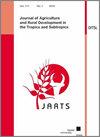豇豆(Vigna unguiculata, L.)品种多样性及生产体系评价Walp.)在尼日利亚西南部
Q3 Social Sciences
Journal of Agriculture and Rural Development in the Tropics and Subtropics
Pub Date : 2018-01-01
DOI:10.17170/KOBRA-2018121864
引用次数: 16
摘要
豇豆(Vigna unguiculata)Walp.)是尼日利亚消费的植物蛋白的最重要来源,主要供应来自该国北部。然而,由于叛乱导致供应减少导致价格急剧上涨,特别是在尼日利亚西南部,那里的豇豆是各种美食的美味。西南适宜农业生态的可持续增产取决于栽培品种的适宜性和农民的生产实践。对农民种植的豇豆品种、品种属性、农民偏好和生产制约因素进行了研究。数据是通过对尼日利亚西南部翁多州和奥约州120名农民采用多阶段抽样技术进行的农场调查产生的。豇豆生产以男性为主,占耕地面积的20.8%,平均每户农户0.96公顷,分布在大约三个地点。51.6%的农民种植本地品种,种子主要来自当地市场(62.7%)。豇豆主要作为间作种植(55.1%),特别是与木薯一起种植。在豇豆生产中,农民主要使用除草剂和杀虫剂,而很少使用化肥(12.8%)。农民所珍视的显著特征包括棕色或白色的被毛颜色,光滑的质地和中等大小的籽粒,直立或匍匐生长模式,以及长豆荚。农民田间豇豆的平均产量为530 kg ha - 1,而优质种子的获取不足、田间害虫和啮齿动物(仓储害虫)的发生率是农民认为最严重的生产制约因素。应该引进以社区为基础的种子生产系统,以改善获得优质种子的机会。本文章由计算机程序翻译,如有差异,请以英文原文为准。
Assessment of varietal diversity and production systems of cowpea (Vigna unguiculata (L.) Walp.) in Southwest Nigeria
Cowpea ( Vigna unguiculata (L.) Walp.) is the most important source of plant protein consumed in Nigeria with major supplies coming from the northern part of the country. However, reduction in supplies due to insurgency resulted in sharp increases in price, especially in Southwest Nigeria where cowpea is relished in different delicacies. Sustainable production increase in suitable Southwest agro-ecologies depends on suitability of cultivated varieties and production practices of the farmers. A study was conducted to identify cowpea varieties cultivated by farmers, the varietal attributes, farmers’ preferences, and production constraints. Data were generated through a farm survey of 120 farmers selected by multi-stage sampling technique in Ondo and Oyo States of Southwest Nigeria. Cowpea production was male dominated, with 20.8 % of cultivated area allocated to its production, averaging 0.96 ha per farm household, fragmented over circa three locations. Local varieties were cultivated by 51.6 % of the farmers with seeds sourced mainly from local markets (62.7 %). Cowpea was mainly cultivated as intercrop (55.1 %) notably with cassava. Herbicides and insecticides were prominently used by the farmers while fertiliser was hardly used for cowpea production (12.8 %). Notable attributes cherished by farmers included brown or white coat colour, smooth texture and medium sized grains, erect or creeping growth pattern, and long pod length. Average yield of cowpea on farmers’ field was 530 kg ha −1 while inadequate access to quality seeds, incidence of field insect pests, and rodents (storage pest) were identified as the most severe production constraints by the farmers. Community-based seed production systems should be introduced for improved access to quality seed.
求助全文
通过发布文献求助,成功后即可免费获取论文全文。
去求助
来源期刊
CiteScore
2.30
自引率
0.00%
发文量
0
审稿时长
>36 weeks
期刊介绍:
The Journal of Agriculture and Rural Development in the Tropics and Subtropics publishes papers dealing with original research and review papers in the fields of plant production, animal nutrition and animal husbandry, soil science, rural economy and farm management, forestry and forest economy, veterinary hygiene and protection against epidemics.

 求助内容:
求助内容: 应助结果提醒方式:
应助结果提醒方式:


